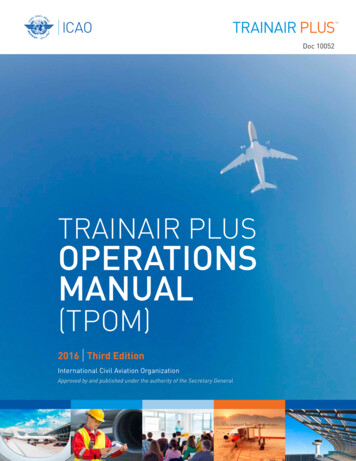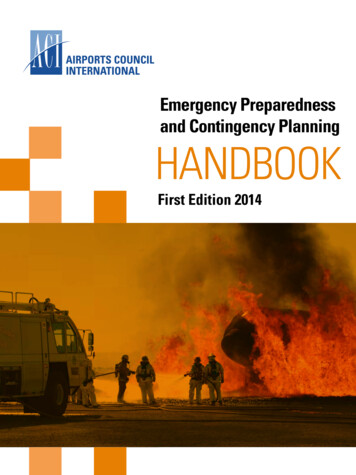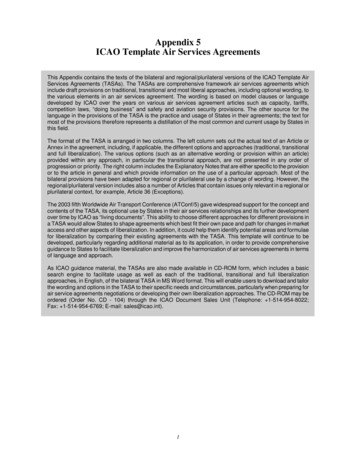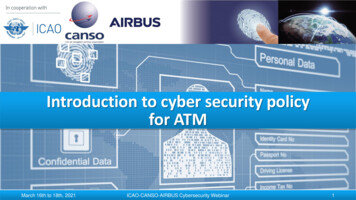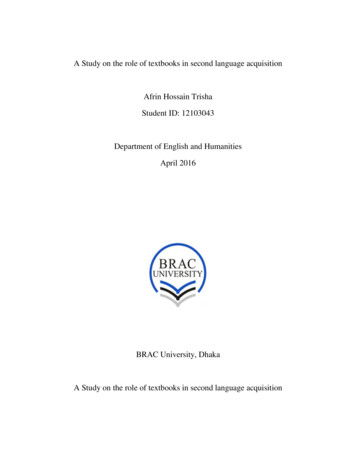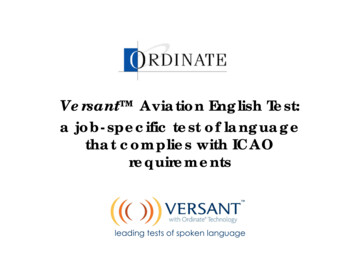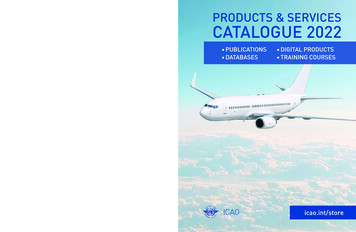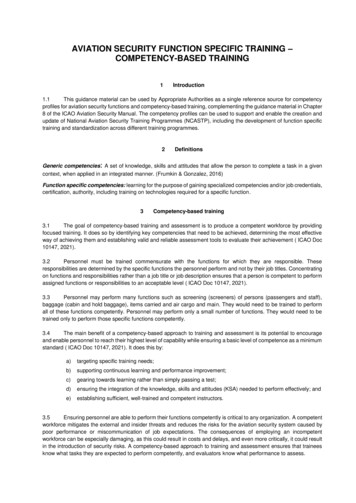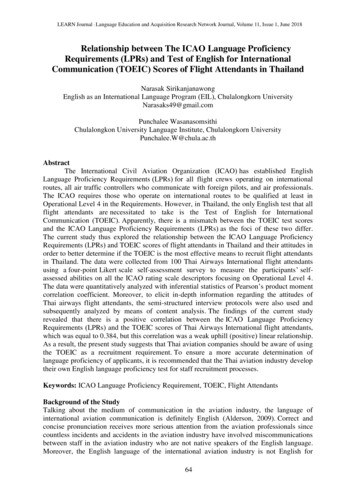
Transcription
LEARN Journal : Language Education and Acquisition Research Network Journal, Volume 11, Issue 1, June 2018Relationship between The ICAO Language ProficiencyRequirements (LPRs) and Test of English for InternationalCommunication (TOEIC) Scores of Flight Attendants in ThailandNarasak SirikanjanawongEnglish as an International Language Program (EIL), Chulalongkorn UniversityNarasaks49@gmail.comPunchalee WasanasomsithiChulalongkon University Language Institute, Chulalongkorn UniversityPunchalee.W@chula.ac.thAbstractThe International Civil Aviation Organization (ICAO) has established EnglishLanguage Proficiency Requirements (LPRs) for all flight crews operating on internationalroutes, all air traffic controllers who communicate with foreign pilots, and air professionals.The ICAO requires those who operate on international routes to be qualified at least inOperational Level 4 in the Requirements. However, in Thailand, the only English test that allflight attendants are necessitated to take is the Test of English for InternationalCommunication (TOEIC). Apparently, there is a mismatch between the TOEIC test scoresand the ICAO Language Proficiency Requirements (LPRs) as the foci of these two differ.The current study thus explored the relationship between the ICAO Language ProficiencyRequirements (LPRs) and TOEIC scores of flight attendants in Thailand and their attitudes inorder to better determine if the TOEIC is the most effective means to recruit flight attendantsin Thailand. The data were collected from 100 Thai Airways International flight attendantsusing a four-point Likert scale self-assessment survey to measure the participants’ selfassessed abilities on all the ICAO rating scale descriptors focusing on Operational Level 4.The data were quantitatively analyzed with inferential statistics of Pearson’s product momentcorrelation coefficient. Moreover, to elicit in-depth information regarding the attitudes ofThai airways flight attendants, the semi-structured interview protocols were also used andsubsequently analyzed by means of content analysis. The findings of the current studyrevealed that there is a positive correlation between the ICAO Language ProficiencyRequirements (LPRs) and the TOEIC scores of Thai Airways International flight attendants,which was equal to 0.384, but this correlation was a weak uphill (positive) linear relationship.As a result, the present study suggests that Thai aviation companies should be aware of usingthe TOEIC as a recruitment requirement. To ensure a more accurate determination oflanguage proficiency of applicants, it is recommended that the Thai aviation industry developtheir own English language proficiency test for staff recruitment processes.Keywords: ICAO Language Proficiency Requirement, TOEIC, Flight AttendantsBackground of the StudyTalking about the medium of communication in the aviation industry, the language ofinternational aviation communication is definitely English (Alderson, 2009). Correct andconcise pronunciation receives more serious attention from the aviation professionals sincecountless incidents and accidents in the aviation industry have involved miscommunicationsbetween staff in the aviation industry who are not native speakers of the English language.Moreover, the English language of the international aviation industry is not English for64
LEARN Journal : Language Education and Acquisition Research Network Journal, Volume 11, Issue 1, June 2018general purposes. Rather, it can be categorized as English for specific purposes or ESP.However, Douglas (2000) has pointed out that ESP for the aviation industry is even morerestricted than that. Much of the aviation English can be classified as a code that is used in avery restricted context known as standard phraseology. As the safety in the aviation industryrelies on clear and accurate communication between interlocutors, ambiguous or incorrect useof English in the aviation industry can result in catastrophic outcomes that need to be avoidedat all costs.According to Martin (2016), aviation English includes the ability to speak, write, andunderstand—in English—aviation meteorology, physics, navigation, maps and charts,electronics and avionics, instrumentation, hydraulics, rules of the air, air traffic controlregulations, and much more. Precisely speaking, unambiguous and accurate communicationsin English, both in the air and on the ground, are very important to the international aviationworkers to do their job effectively for the safety of everyone involved. Alderson (2009) haspointed out that many serious miscommunications can occur in unpredictable situations,particularly in emergencies, and especially where urgent corrective action or essentialinformation is involved, and where one of the interlocutors may be under severe emotionalstress. This supports the idea that speaking skills in oral communication is the most importantskill in aviation English. However, it is noteworthy that English in the aviation industry notonly encompasses speaking with correct pronunciation, but, according to Ketchum (2007), italso demands communication skills that go hand in hand with reading and writing skills.Simply put, the more one reads and writes, the more one can broaden his or her vocabularyand articulate concepts accurately and more effectively to others. Apart from reading, in theaviation industry, writing skills are found important as they are compulsory in operationalsystems and maintenance which are considered safety-critical (Sarmento, 2005). However,the significance of writing in the aviation industry may be overlooked due to the fact that thewritten language used in maintenance documents is often considered “simplified English,” sopeople involved in the industry tend to pay more attention to speaking.The ICAO, a specialized agency of the United Nations, has developed and proposedairline safety standards and practices which require flight crew members, air trafficcontrollers, and air professionals (including flight attendants) to be able to communicateproficiently using both ICAO phraseology and plain English called the ICAO languageproficiency requirements (LPRs). It has identified six areas of language competency in whichaviation personnel must be proficient including the following: pronunciation, structure,vocabulary, fluency, comprehension, and interactions (ICAO, 2004). Each skill is dividedinto six levels of proficiency, namely Level 1 (pre-elementary), Level 2 (elementary), Level 3(pre-operational), Level 4 (operational), Level 5 (extended), and Level 6 (expert). In order tobe qualified to work in the aviation industry, it is compulsory for flight crews including flightattendants to pass the Operational level 4 of the requirements. Even though the ICAOlanguage proficiency test is designed for and administered specifically with only pilots, withparts of the test concerning the radio communications, flight attendants are still required tomeet the specification. This is because it is believed that they still need to be able to use thelanguage to fulfill their duties including providing food and beverages to passengers andensuring safety and taking care of passengers in an emergency, in addition to having theoverall knowledge about the aircraft they fly (ICAO, 2008). In addition to this, the Englishlanguage proficiency of flight attendants is what ICAO takes into serious consideration,particularly when there is an emergency in which flight attendants have to be thecommunicators between pilots and passengers with different language backgrounds. Moreimportantly, in case of medical emergencies, flight attendants’ ability to use English tocommunicate with different parties to assist passengers is even more crucial. For these65
LEARN Journal : Language Education and Acquisition Research Network Journal, Volume 11, Issue 1, June 2018reasons, it is deemed vital that airline companies make sure that their flight attendants meetthe standards set by ICAO.However, in reality, for many international flight attendants, English is not their firstlanguage. They understand, however, that if they want to fly internationally as a career, theirEnglish must be fluent to a great extent. Nevertheless, the English proficiency of flightattendants in Thailand in general has been found to be lower than the standards (Permtanjit,2003). It has been documented that the two largest areas of difficulty in the English languageof flight attendants are unfamiliarity with passengers’ accents and their own accents andpronunciation. Without effective English communication skills, a flight attendant may find itdifficult to fulfill their job descriptions effectively and impossible to climb up the corporateladder. Apart from this, good English skills help the aviation professionals develop andmaintain the relationships with colleagues and ensure that arguments and disagreements arekept to a minimum.At present, however, the only English test that all flight attendants recruited in Thailandare required to take is the Test of English for International Communication (TOEIC), whichneeds to be taken before they apply for the job. This is a rather common practice amongmost of the airlines in the world. Since the score range for those who can apply for theposition is quite wide (from 600 to 990 points), the English language proficiency of flightattendants varies. Thus, it can be seen that the ICAO language proficiency standard and trueproficiency of flight attendants may not be congruent in every case. The ICAO sets thestandards of language proficiency of those who work in the aviation industry called the ICAOLanguage Proficiency Requirements (LPRs). Those who work in this industry must bequalified at least in Operational Level 4 in the requirements. In reality, however, flightattendants whose TOEIC score is higher than 600 points (the cut-off score for eligibility towork in the aviation industry) may or may not have to reach this Operational Level.Consequently, it can be stated that currently there is a mismatch between the TOEIC testscores and the ICAO Language Proficiency Requirements (LPRs). One plausible explanationis that the TOEIC test is designed for business purposes, while aviation English is considereda language of specific purposes. Simply put, whether the TOEIC scores are appropriate forrecruiting workers in the aviation industry may need to be reconsidered due to its constructunderrepresentation.For these reasons, in order to elevate the English language proficiency standard of flightattendants in Thailand’s aviation industry, the correlation between the ICAO LanguageProficiency Requirements (LPRs) and Test of English for International Communication(TOEIC) needs to be explored to more empirically determine whether those who have theTOEIC scores ranging from 600 to 990 points are truly qualified at the Operational Level inthe ICAO Language Proficiency Requirements (LPRs). If not, a new English test (English forspecific purposes) specifically designed for recruitment of staff in the aviation industry mayneed to be developed so as to help the aviation industry in Thailand find the most reliable andeffective means to recruit personnel into the industry. Also, flight attendants in Thailand’saviation industry who do not meet the English proficiency standard of the ICAO may need tofurther improve themselves to acquire it, or risk being removed from international flightroutes.Based on the necessity of aviation professionals to achieve the standard proficiency ofEnglish, this study aimed to investigate the relationship between the ICAO languageProficiency Requirements (LPRs) and the TOEIC scores of flight attendants in Thailand inorder to reconfirm the effectiveness of TOEIC-based recruitment of flight attendants inThailand. Moreover, the attitudes of flight attendants in Thailand toward the ICAO languageProficiency Requirements and the TOEIC test were also explored.66
LEARN Journal : Language Education and Acquisition Research Network Journal, Volume 11, Issue 1, June 2018ICAO Language Proficiency RequirementsICAO stands for The International Civil Aviation Organization, which is a United Nationsspecialized organization. It was established by the United States in 1944 to manage theadministration and governance of the Convention on International Civil Aviation (ChicagoConvention). This agency is also responsible for producing global plans to assistmultinational airlines about safety and navigation, monitoring and reporting air transportperformance metrics, in particular, and auditing airlines organizations to maximize safetyand security. Moreover, ICAO also sets language standards in order to control the use ofEnglish as an international language of the air by making the language requirements calledthe “ICAO Language Proficiency Requirements” (Estival, Farris, & Molesworth, 2016).In this study, the ICAO Language Proficiency Requirements refer to a set of languagerules that all flight crews have to follow. They consist of a set of holistic descriptors such as“Proficient speakers shall communicate effectively in voice-only (telephone/radiotelephone)and in face-to-face situations,” “Proficient speakers shall use a dialect or accent which isintelligible to the aeronautical community,” and “Operational Level 4 of the ICAO RatingScale is the requirement for flight crews and air traffic controllers.” These new standardsinstruct flight crews and air traffic controllers to be able to communicate proficiently usingboth ICAO phraseology and general English. The core content of the ICAO LanguageProficiency Requirements is that all aviation professionals engaged in or being in contactwith international flights must be proficient in the English language as a general spokenmedium, not simply having a proficiency in standard ICAO Radiotelephony Phraseology.The ICAO language proficiency requirements are significantly crucial for aviationprofessionals because they necessitated all aviation professionals to acquire at leastOperational Level 4 in order to be accepted into the industry. The requirements in all levelsare divided into six domains: pronunciation, structure, vocabulary, fluency,comprehension, and interaction.Alderson (2009) has pointed out that while there is some argument over the qualityof these scales, they are still used in the assessment of proficiency of applicants of aviationlicenses. Parohinog and Meesri (2015) have investigated the proficiency of aviationstudents based on the six domains of the aforementioned ICAO language proficiencyrequirements and found that the difficulties that students in Thailand have encountered inthe six domains of the ICAO language Proficiency Requirements were particularlygrammar or structure, followed by interaction.TOEIC TestThe TOEIC test refers to the Test of English for International Communication (TOEIC)that is specifically designed to measure the ability of test-takers who are non-native Englishspeakers to use English in everyday life, especially work-related activities. The TOEIC hasbeen developed by Educational Testing Service (ETS), the world’s biggest privatenonprofit educational testing and assessment organization, based in the USA, following arequest from the Japanese Ministry of Foreign Trade and Industry (MITI). ETS is also thedeveloper of the TOEFL, one of the most well-known standardized language proficiencytests primarily used in the USA and all over the world for admission into educationalinstitutions (Runnels, 2014).The purpose of the TOEIC test is to measure language proficiency in terms ofeveryday English skills of people working in an international environment (Powers, Kim,& Weng, 2008). In other words, the TOEIC test measures a person’s ability tocommunicate in English in the context of daily life and the global workplace environmentusing key expressions and common, everyday vocabulary. The scores indicate how welltest takers can communicate in English with others in the workplace. These TOEIC scores67
LEARN Journal : Language Education and Acquisition Research Network Journal, Volume 11, Issue 1, June 2018are widely used to determine the proficiency levels of employees or potential employees,for human resources planning and development in the contexts of business, industry, andcommerce (Powers et al., 2008).The TOEIC test has been used for the recruitment of staff at Thai AirwaysInternational for years. The importance of the TOEIC exam is that Thai AirwaysInternational, the biggest airline company operating in Thailand, recruits an average of100-150 new flight attendants every one to two years partly based on their TOEIC scores.The recruitment process takes over two weeks for screening, and more than 10,000 walk-incandidates undergo basic academic, skill, and physical fitness assessments, a very laborintensive process. Unfortunately, a large number of applicants are not selected as each yearonly 30-35% meet Thai Airways International’s minimum TOEIC score of 500, whichqualifies them for additional interviews and tests (ETS, 2007; Powers et al., 2008).Since English is an important skill for the career as a flight attendant, and in fact aminimally acceptable level of English has already been determined by Thai AirwaysInternational (as represented by the TOEIC score of 500 since 1988), ETS has proposedthat Thai airways adjust the process to move the English testing from the end of the processof screening to the beginning of the process (before screening). In other words, ThaiAirways International should first pay attention to English skills of the applicants apartfrom their education, attitude, personality, and general appearance. This change shouldhelp Thai Airways International to refine the recruitment process to end up with a morehomogenous group of eligible applicants. Moreover, the refinement cuts down manyrecruitment expenses and reduces staff working in the recruitment process.Self-AssessmentThe ability to self-assess is often seen as a key characteristic of an autonomous languagelearner (Gardner, 2000) where autonomy refers to a learner’s ability to take care of and beresponsible for their own learning (Holec, 1981). Moreover, Holec (1981) posits that selfassessment is a tool which supports those with that ability. An assessment may serve manypurposes, such as measuring progress, proficiency, motivation, or confidence (Gardner &Miller, 1999). According to Race (2001), self-assessment is a method that allows students tojudge their own work such as reports, essays, presentations, and even exam papers.Gardner (2000) describes the benefits of self-assessment that can extend beyondlearners to teachers and also to the institution. Learners benefit the most from self-assessmentand in very diverse ways. Oscarson (1997) explains that it is not only the teacher who gets thebenefits from self-assessment to improve and expand their teaching techniques, but it is alsobeneficial for students to raise more goal-oriented motivation in language learning.Moreover, student self-assessment also encourages them to participate more as well as helpsthe teacher to relieve their burden. As Naeini (2011) has pointed out, despite the fact thatcriticisms against self-assessment in terms of validity and reliability still remain, manyscholars have successfully used self-assessment as a teaching method in the classroom toimprove classroom instruction.According to Popper (1959) and Ackroyd and Hughes (1981), there are a number ofadvantages of using a questionnaire as a tool to collect data. First, a questionnaire is a toolthat helps gather a large amount of information in a short period of time from any number ofparticipants with limited effect on its validity and reliability. Secondly, a questionnaire is ascientific data collection tool that yields quantitative data that can be used not only tocompare and contrast data, but to formulate a new theory or hypothesis.Coombe and Canning (2002) point out that in spite of the criticisms against selfassessment in terms of its validity and reliability, it is generally believed that if a self-68
LEARN Journal : Language Education and Acquisition Research Network Journal, Volume 11, Issue 1, June 2018assessment instrument is utilized with sufficient care, it can still be both a valid and reliablesupplement to traditional assessment in some ways.It is generally said that successful companies put the right man on the right job. Thefindings of the present study can be a starting point for Thai Airways International toreconsider whether their existing recruitment process enables them to choose flight attendantswith sufficient levels of English proficiency to ensure their professional performance. If thecompany finds that the TOEIC is not the most suitable proficiency test in accordance with thestandard of ICAO language proficiency, they can use the study findings as evidence of thenecessity to come up with a new English proficiency test, whether another commerciallyavailable test or a newly designed in-house test, so as to more effectively recruit flightattendants to ensure quality service provision and the safety of their passengers.MethodTo explore the correlation between the ICAO Language Proficiency Requirements (LPRs)and Test of English for International Communication (TOEIC) reading and listening scores offlight attendants in Thailand, this study collected the data from Thai Airways Internationalflight attendants who use English as a medium of communication with the passengers. Thereare approximately 3,000 flight attendants of Thai Airways who are responsible for taking careof passengers’ safety and providing food and beverage service to passengers. The flightattendants of Thai Airways International consist of both males and females whose age rangeis between 22 and 60 years old. All of them are Thai nationals and their first language is alsoThai. The participants of this study were 100 flight attendants working in the economy classof Thai Airways International, all of whom were recruited by means of purposive sampling.There were two inclusion criteria. First, they had been working with the company for morethan 12 months to ensure that they had gained some experience using the English language intheir line of work. Second, they had to have the updated TOEIC scores taken no more thantwo years ago to reflect their ability to use English as a medium of communication with thepassengers while working. Yamane’s (1967) formula was used in order to find the propersample size, which was 100, with the margin of error being approximately 10%.The instruments used in this study was the self-assessment survey developed by theresearcher based on the ICAO Language Proficiency Requirements (LPRs) descriptors (seeAppendix) such as item 1.2) You can demonstrate a marked accent. �� ยงเสี ยงหนักเบาได้ชดั เจน) and item 2.2) You can make a good command of basic grammatical structure. ฐานได้เป็ นอย่างดี). The participants responded to the following stemcompletion item: “To what extent do you agree with the following statements (where 1 was‘strongly disagree’ and 4 meant ‘strongly agree’)?” The four-point Likert scale was employedto measure the participants’ self-assessed abilities on all of the ICAO rating scale descriptorsfocusing on Operational Level 4 consisting of six domains: pronunciation, structure,vocabulary, fluency, comprehension, and interaction. The four-point scale was selected toreduce the participants’ tendency of selecting a neutral response (Dörnyei & Taguchi, 2010).The survey was validated by a panel of three experts in English for specific purposes andassessment before use. The ICAO Language Proficiency Requirements (LPRs) selfassessment survey was written in both Thai and English and it was available for freedownload at www.doc.google.com. Oscarson (1997) has suggested that a self-assessmenthas generally been found to be more accurate when administered in the native language of therespondents. In this study, however, the participants were requested to complete the survey inEnglish as they were supposed to be qualified to do so.69
LEARN Journal : Language Education and Acquisition Research Network Journal, Volume 11, Issue 1, June 2018To complete the investigation of the correlation process, the Test of English forInternational Communication (TOEIC) listening and reading tests were also taken intoconsideration. As a rule, all participants had to have the TOEIC score of 600 to 990 points inorder to qualify for job requirements of Thai Airways. In this study, they were expected tospecify the TOEIC scores they had when they applied for the job with the airline.Moreover, to elicit in-depth information regarding the attitudes of Thai AirwaysInternational flight attendants towards the ICAO Language Proficiency Requirements (LPRs)and the TOEIC test, the semi-structured interview protocols were designed and administeredby the researcher. After undergoing a validation process, ten interview participants werepurposively selected after completing the self-assessment survey, and the interviews of theten selected participants were conducted by the researcher in English. This was because theinterview participants were those with a higher level of proficiency and the researcher wantedto avoid misinterpreting the interviewees’ original messages when translating the interviewdata from Thai to English. The interview took place at Thai Airways Operations Center, eachof which took 15 to 20 minutes to complete.The data from the self-assessment surveys and interviews were analyzed by means ofstatistical analysis using the SPSS Program for Windows. First, quantitative data gatheredwith the self-assessment surveys were analyzed with descriptive statistics of percentage,mean, and standard deviation, and Pearson’s product moment correlation coefficient was alsoutilized to determine the correlation between the self-assessment surveys and the TOEICscores. On the other hand, qualitative data collected using the interview protocols wereanalyzed by means of content analysis.Findings and DiscussionsEnglish Proficiency of Flight AttendantsThe population of this study is 3,000 Thai Airways International flight attendants who useEnglish as a medium of communication while taking care of passengers’ safety and providingfood and beverage service to passengers. The flight attendants of Thai Airways Internationalconsist of both males and females whose age range is between 22 and 60 years old.Of the 100 Thai Airways International flight attendants who completed the selfassessment surveys, the minimum TOEIC score was 680 and the maximum score was 990,with the mean TOEIC score of 830.30 which falls into the B2 level of the Common EuropeanFramework of References (CEFR). According to ETS (2008, 2013), a TOEIC examineewhose TOEIC score falls into the level B1 and B2 of CEFR is an independent user who canunderstand the main points of standard input, interact with most situations, and producesimple connected texts, which is considered sufficient to work effectively as a flightattendant.Table 1. TOEIC Scores and the ICAO LPRs Scores (n 100)TOEIC ScoresICAO LPRsMinMaxMeanStd. Deviation68091990153830.30120.3481.1710.9570
LEARN Journal : Language Education and Acquisition Research Network Journal, Volume 11, Issue 1, June 2018Relationship between the Test of English for International Communication (TOEIC)scores and the ICAO Language Proficiency Requirements (LPRs) self-assessments ofThai Airways International flight attendantsTo address the first research question, i.e., What is the relationship between the ICAOLanguage Proficiency Requirements (LPRs) and Test of English for InternationalCommunication (TOEIC) of Thai Airways International flight attendants?, the summaryscores of the self-assessment survey and TOEIC score of each participant were correlatedusing inferential statistics of Pearson’s Product Moment Correlation. When considering thecorrelation between the ICAO Language Proficiency requirements (LPRs) and Test ofEnglish for International Communication (TOEIC) of Thai Airways International flightattendants, it could be seen that there was a positive correlation between the ICAO LanguageProficiency Requirements scores (LPRs) (M 120.3400, SD 10.94551) and Test of Englishfor International Communication (TOEIC) scores of Thai Airways International flightattendants (M 830.300, SD 81.17141), which was equal to 0.384, but this correlation wasa weak uphill (positive) linear relationship. It was also found that the correlation between theICAO Language Proficiency Requirements (LPRs) and the Test of English for InternationalCommunication (TOEIC) of Thai Airways International flight attendants was statisticallysignificant at the 0.01 level (2-tailed).Table 2Relationship between the TOEIC test scores and the ICAO LPRs scoresPearson CorrelationTOEIC ScoresSig. (2-tailed)N**Correlation was significant at the 0.01 level (2-tailed)TOEICICAO LPRs1.38**.000100100One plausible explanation for the weak correlation between the ICAO LanguageProficiency Requirements (LPRs) score and the Test of English for InternationalCommunication (TOEIC) score of Thai Airways International flight attendants is probablythe mismatch in the contents of the TOEIC test and the ICAO Language ProficiencyRequirements (LPRs) self-assessment survey. According to Ross (1998), the self-assessmentaccuracy will be found low if the contents of the test and the self-assessment materials do notmatch. The TOEIC test focuses on the everyday English use of people who work in aninternational environment; on the other hand, the ICAO Language Proficiency Requirements(LPRs) involve the use of English for specific purposes, namely aviation English, thatincludes the ability to speak, write, and understand (listen and read) aviation meteorology,physics, navigation, maps and charts, electronics and avionics, instrum
LEARN Journal : Language Education and Acquisition Research Network Journal, Volume 11, Issue 1, June 2018 66 reasons, it is deemed vital that airline companies make sure that their flight attendants meet the standards set by ICAO. However, in reality, for many international flight attendants, English is not their first language.



